Introduction
A sport practice is confined to a specific moment, shared by a particular group of people, all pursuing a common goal. The types of drills (i.e. skill development), strategy (i.e. competition preparation), and conditioning (i.e. physical and mental training) are determined by the type of sport and the level of competition. Coaches are the orchestrators and key ingredients to an effective practice. They plan the activities, serve as the lead teachers, and motivate athletes to come together as a team.
The basic elements for effective practices can be developed and nurtured by coaches of all levels (i.e. youth, high school, college, professional). In this article, four key elements for developing an effective practice are discussed: 1) establishing standards of performance, 2) designing activities with a purpose, 3) creating a safe learning environment, and 4) communicating clearly. An example of all (4) elements in action is also provided.
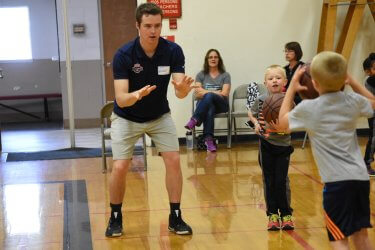
Establishing Standards of Performance
An effective practice session is built on a culture of high expectations, centered around standards of performance. A standard is a measurable objective that pushes athletes to rise to a higher level of performance. If a tennis coach requires an athlete to demonstrate competence in where they place a specific number of serves, they have established a standard of performance in executing a particular skill. When a volleyball coach demands that all players wear team assigned practice gear each day, a standard of performance aligned around team unity is created. The performance standards a coach establishes are based on the coach’s values. The values of the coach originate from their personal background, previous athletic experience, and development as coach.
To establish standards of performance, begin by reflecting on your personal values and clarifying what you believe in. Start by making a values list. Values should reflect what is important to you, where you spend your time, and what you are striving to be as a person. Ask yourself, what characteristics and traits you want your players to develop under your guidance? Next, write a brief statement for each value describing why that particular value is important to you. Review each value statement. Through carefully reading and reflecting on these you’ll discover what you believe in and begin to establish standards of performance.
After reflecting on personal values, you should identify the governing body of sport or national sport organization that bests represents the sport and level you coach. Using resources provided by these sport organizations, you can identify or confirm appropriate performance standards. Consider seeking out the assistance of more knowledgeable coaches. Finally, when crafting your performance standards, focus on age appropriate fundamental skill development and competition preparation guidelines. An example of this process is illustrated in Table 1.
Table 1: Establishing Standards of Performance
| Steps | Examples |
| 1. Make a list of your values | Respect, Responsibility, Family, Friends, Honesty, Integrity, Hard Work, etc. |
| 2. Write a brief statement that describes what the value means to you | Value: Responsibility
Value Statement: Being accountable for my actions and holding others to those same standards. |
| 3. Review all value statements | Identify the keys themes across all value statements. |
| 4. Recognize what you believe in and write one or more statements that can drive your action in working with your team | “I believe that each person has unique talents and gifts and it is my job as a leader to help them discover them.” |
| 5. Identify the governing body or national organization of sport | United Soccer Coaches, National Alliance for Youth Sport (NAYS), USA Volleyball, American Football Coaches Association (AFCA), USA Basketball, United States Tennis Association (USTA) |
| 6. Seek assistance from a more knowledgeable coach | Identify coaches in and outside of your sport that have demonstrated expertise in establishing performance standards for their team |
| 7. Create practice performance standards | a) (Respect) Each athlete will address members of the coaching staff as “Coach _____” b) (Team Development) Each athlete will acknowledge a teammate’s assistance in helping them be successful (i.e. assist in basketball). c) (Skill Development) Each athlete will make 100 touches with the soccer ball prior to the start of practice. |
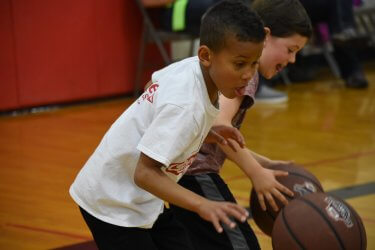
Designing Purposeful Activities
A well-planned practice builds the foundation for an effective practice session. This is a deliberate action by the coach to organize activities to ensure player and team development. The type of activities being planned should have an instructional focus chosen to achieve program goals. To design purposeful activities, follow these four steps:
- Confirm the athlete development goals already established by the organization (i.e. school district, YMCA) you work for.This will vary depending on your athletes’ age level and whether the sport is participation (i.e. recreational) or performance (i.e. developmental) focused.
- Select age-level appropriate instructional drills, games, and scrimmage situations.
- Design each activity to move the athletes’ closer to achieving the goals of the program.
- Evaluate the activity and adapt future practice sessions to ensure desired outcomes are being met. Table 2 illustrates these steps.
Table 2: Designing Purposeful Activities
| Designing Purposeful Activities | Example
Youth Soccer Ages 9-10 |
| 1. Confirm athlete development goals | Child-centered philosophy where every participant, regardless of ability, has the opportunity to have a positive youth sport experience (NAYS, 2017) |
| 2. Select age-level appropriate drills, games, and scrimmage situations | Skill development, concentration on fundamentals, progressive introduction to simple offensive or defensive schematics and introduction of internal competition (NAYS, 2017) |
| 3. Design each activity to achieve the program goals | High repetition fundamental drill work, instructional focused feedback, player position rotation in scrimmage and game situations |
| 4. Evaluate and adapt to ensure desired outcome | Post practice reflection, note changes needed, plan next practice |
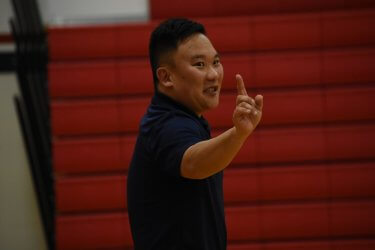
Creating a Safe Learning Environment
An effective practice session offers each athlete a place to learn and grow in a setting where they are emotionally and physically safe. Each athlete should feel supported with instruction by coaches designed to develop athletes’ competence and confidence. Coaches must take a proactive approach to guarantee each athlete is respected and free from any type of harassment, hazing, or bullying. To provide a safe learning environment, you must first take responsibility to create an emotional and physical safe setting for each practice. This is a proactive way you can create a culture around the team that influences athlete actions away from the field of play. Second, be sure you become aware of the individual differences amongst athletes and understand why they are participating. Third, focus instruction and feedback on attitude and performance execution rather than results. Finally, promote a shared leadership approach that helps athletes feel connected to the team. See the example in Table 3.
Table 3: Creating a Safe Learning Environment
| Creating a Safe Environment | Suggestions |
| 1. Take responsibility to create an emotionally and physically safe practice setting | a) Have a zero-tolerance policy for harassment, hazing, or bullying b) Teach and reinforce that failure is part of the learning process c) Use words or phrases that instruct, encourage, and reinforce positive behaviors |
| 2. Seek to understand why athletes are participating | a) Take initiate and interact with athletes in settings away from the field of play (i.e. waiting for a bus, team meals, before or after practice) b) Pay attention to current trends and topics of importance to the age group you are coaching c) Ask them why they are playing |
| 3. Focus instruction and feedback on attitude and performance execution | Reward hustle plays and reinforce behavior that supports performance standards |
| 4. Promote a shared leadership approach | Empower your athletes to create standards of performance that reinforce the program values and goals already established |
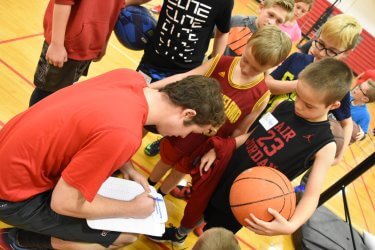
Clear Communication
The foundation of an effective practice session ultimately rests on the ability of coaches to provide clear and consistent communication. Communication is a mix of verbal (i.e. word choice and tone) and non-verbal (i.e. body language) signals sent by coaches to their athletes. Your ability to role-model appropriate behavior and control your emotions will impact your athletes’ performance. To provide effective communication, consider the types of words being used when talking to athletes. This includes the tone of your voice and how the word is used in a particular context. How approachable you appear to your athletes is also based on your body language. It is helpful to ask questions for clarity and to facilitate understanding. Finally, in providing effective communication give feedback that is specific and deliberately timed for the greatest impact. See Table 4 for examples of these steps.
Table 4: Communication
| Communicating with Athletes | Suggestions |
| 1. Consider word choice | a) Avoid the use of slang or swear words b) Use appropriate and current terminology c) Maintain a positive tone |
| 2. Evaluate body language | a) Be active and move amongst the athletes b) Maintain an open posture c) Smile |
| 3. Ask questions for clarity | a) Ask athletes questions that create action and understanding (Berger, 2015). For example, a Cross Country Coach teaching proper nutritional habits might ask: How can we improve individual performance between practices through nutrition? |
| 4. Specific and deliberate feedback (Gilbert, 2016) | a) Identity desirable and correct behaviors b) Identify errors and undesirable behavior c) Focus on the behavior, not the person d) Provide a solution for improvement |
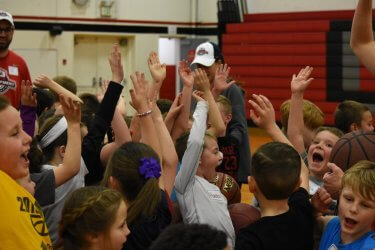
In Action: Designing Effective Practice Sessions
Gold medal winning coach, Don Showalter honed and developed his ability to deliver effective practice sessions throughout his 44 years as a basketball coach at the youth, middle school, high school and elite level. Over the last 10 years as the head coach of USA Men’s Basketball U16 and U17 National Teams, he has amassed a 62-0 record and won ten-straight gold medals. He also spent 42 years as a high school coach in Iowa accumulating over 600 wins. In 2009Don was named the National High School Athletic Coaches Association National Coach of the Year and he was inducted into the Iowa High School Athletic Association (IHSAA) Hall of Fame in 2017. Regardless of the level he is coaching at, Coach Showalter’s approach to designing an effective practice session includes the four elements listed above. Here are some of the ways it looks in practice:
Standards of Performance
In developing the U16-U17 National Basketball Team, one standard of performance Coach Showalter establishes is a mindset focused on going beyond what feels comfortable and challenging yourself to get better. In other words, going beyond your comfort zone. To develop this mindset as a standard of performance, Coach Showalter uses a pre-practice meeting to introduce the standard. For example, he would state, “Go beyond your comfort zone, nothing ever grows there.” He then asks each athlete to write down the statement and describes what it means to them. A discussion ensues with players sharing and Coach Showalter providing examples of how athletes can meet this standard on and off the court. This dialogue helps to establishes the mindset: “Going beyond your comfort zone,” as a standard of performance to strive for each practice.
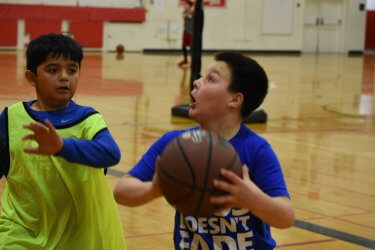
Designing Purposeful Activities
In planning a U16-17 practice, Coach Showalter selects activities that match USA Basketball youth player development guidelines. USA Basketball has established four levels of instructional player content for youth development. These include, introductory, foundational, advanced, and performance levels (USA Basketball, 2018). Each level outlines the balance of fundamental skills and drills with competitive play (See Table 5). For the U16-17 team, the focus is on preparing for international competition (performance level). Therefore, Coach Showalter plans more team-oriented type drills and includes time to prepare specifically for competition.
Table 5: Levels of Instructional Player Content for Youth Basketball
| Level | Age Level | Description | Training to Competition Ratio |
| Introductory | 3 – 9 | Learn fundamental movement skills and build overall motor skills. | 100% to 0% |
| Foundational | 8 – 13 | Learn all fundamental and basic basketball-specific skills, establish building blocks for overall basketball skills | 70% to 30% |
| Advanced | 12 – 17 | Build the aerobic base, build strength towards the end of the level and further develop overall basketball skills. | 40% to 60% |
| Performance | 15 – 18+ | Maximize fitness and competition preparation as well as individual and position-specific skills. | 25% to 75% |
Source: USA Basketball (2018)
Establishing a Safe Learning Environment
Coach Showalter creates a practice culture where athletes can learn and grow in a supportive environment. For example, he places a strong emphasis on personal responsibility, often stating, “These require zero talent: Being on time, work ethic, effort, body language, energy, attitude, passion, and being coachable.” By focusing on what each athlete can control with effort and attitude, the U16-U17 players develop a sense of accountability for their actions.
Coach Showalter then builds rapport and trust with each athlete on the team through purposeful actions. A few examples include:
- Call players by name first when correcting or complimenting them.
- Give every player four positive comments each practice.
- Speak loudly when praising, speak softly when correcting.
- Pull a player out of a drill for a short instructional time to increase his ability to perform the skill.
- Have a player that does not play much demonstrate skills or actions and then praise him for it.
- Move to different spots on the court and say something to players waiting in line for a drill.
In getting to know each athlete on a more personal level he establishes a mutual level of respect. By creating a space where each athlete feels supported and accountable for their actions, Coach Showalter establishes a safe learning environment where each athlete feels connected to the team and can focus on improving individual performance.
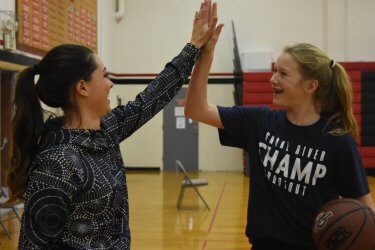
Clear Communication
To effectively manage practice expectations and nurture the practice culture, Coach Showalter strives to communicate clearly and consistently throughout practice sessions (i.e. before, during, and after). During the pre-practice meeting he will share short phrases to inspire athletes, drive home key concepts, and stimulate discussion. These short phrases are referred to as Mind Candy. An example would be, “Success is the sum of small efforts repeated day in and day out.” Mind Candy provide an avenue for Coach Showalter to communicate a consistent message regarding a standard of performance and help athletes maintain focus on team goals.
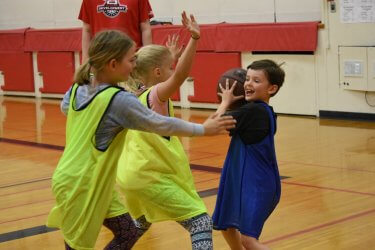
During practice, Coach Showalter teaches in short sound bites so that the message is not lost in a long explanation of a drill or strategy. Examples of sound bites used by Coach Showalter include:
- Stay low
- Shot ready
- Point toe in direction you are going
- Chin up
- Hip to hip for protecting ball
- Cross leg then ball on crossover
- Jump stop for screens
At the end of practice session, Coach Showalter often uses a communication circle to help U16-U17 athletes and coaches connect and understand each other better. In a communication circle players and coaches form a circle and hold hands. Then each person in the circle will share something about themselves based on a specific question. Initially, questions tend to be less personal, such as “What is your favorite food?” and then become more personal, “What is something about you that nobody here knows?” In the process of getting to know each other better through the communication circle, the lines of communication open in all aspects of the team environment.
Conclusion
Building a foundation for an effective practice session is driven by the coach’s ability to implement the four elements outlined above. By reflecting on the example and steps provided you can evaluate and improve your ability for designing effective practice sessions.
References
Berger, W. (2014). A more beautiful question: The power of inquiry to spark breakthrough ideas.Bloomsbury Publishing USA.
Gilbert, W. (2016). Coaching better every season: A year-round system for athlete development and program success. Human Kinetics.
National Alliance for Youth Sports (2017). National Standards for Youth Sports. Retrieved from: https://www.nays.org/resources/nays-documents/national-standards-for-youth-sports/
USA Basketball (2018). Instructional Player Content. Retrieved from: https://www.usab.com/youth/development/youth-development-skill-levels.aspx

I coach the non-traditional sport of jump rope. Many of the thoughts shared here are applied in my practice sessions. My jumpers range from age 7 – 35 +. We give demonstrations and we compete on a local, regional, national and international level. I enjoyed reading and confirming that what I do as valuable as well as the realization that there is always room for improvement.